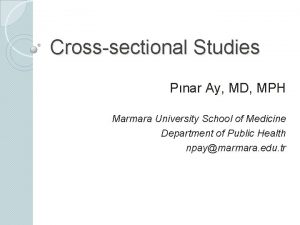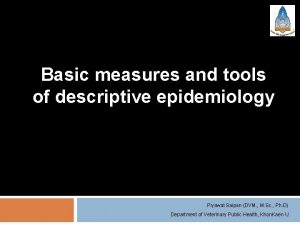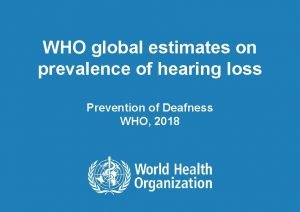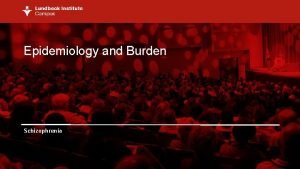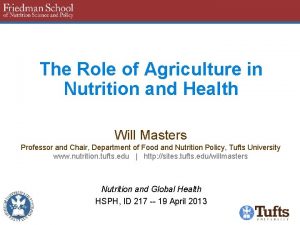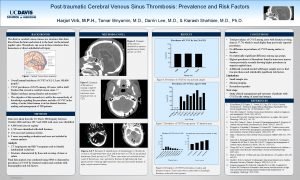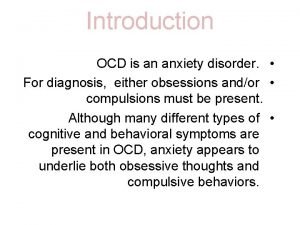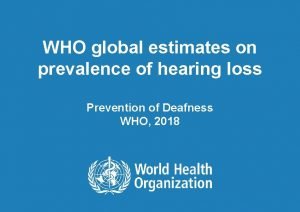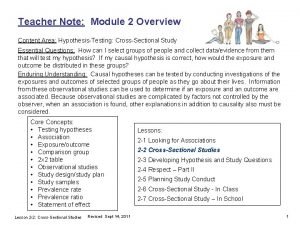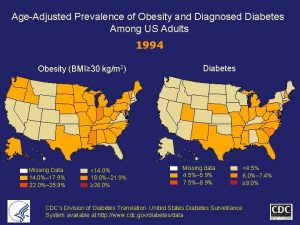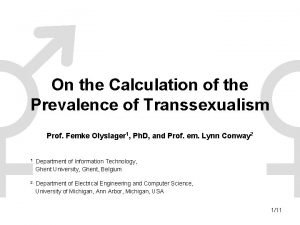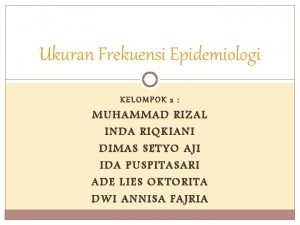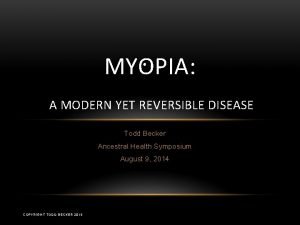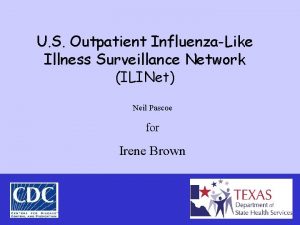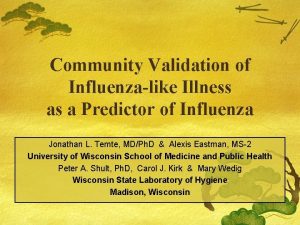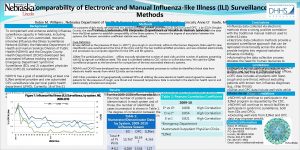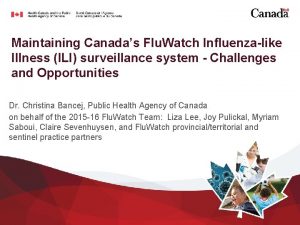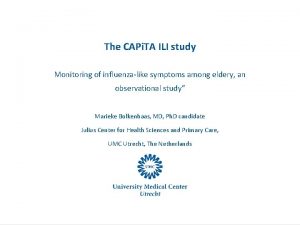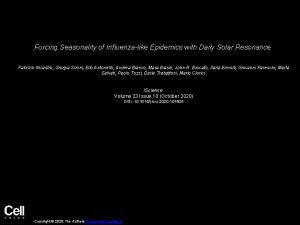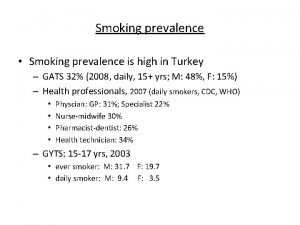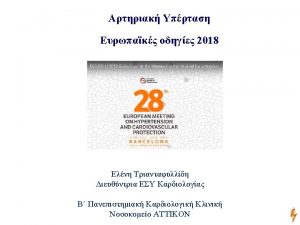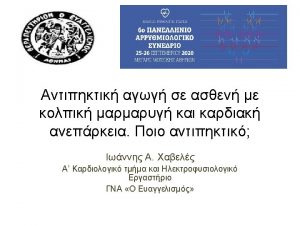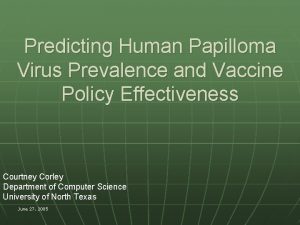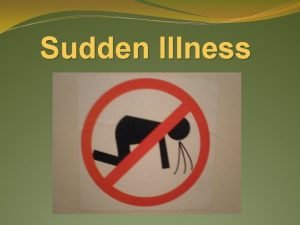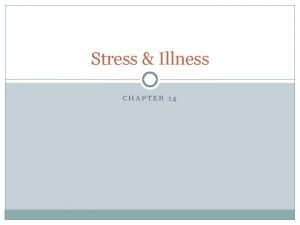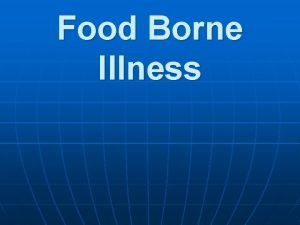PREDICTING PREVALENCE OF INFLUENZALIKE ILLNESS FROM GEOTAGGED TWEETS
























- Slides: 24

PREDICTING PREVALENCE OF INFLUENZA-LIKE ILLNESS FROM GEO-TAGGED TWEETS ADVISER: JIA-LING, KOH SOURCE: WWW’ 17 SPEAKER: MING-CHIEH, CHIANG DATE: 2018/02/27 1

OUTLINE • Introduction • Method • Experiment • Conclusion 2

MOTIVATION 3

MOTIVATION • Modeling disease spread with Twitter data involves several challenges • Only relying on text classification can include large errors 4

GOAL • A strong positive linear correlation exists between the number of ILI-related tweets and the number of recorded influenza notifications at state scale 5

OUTLINE • Introduction • Method • Experiment • Conclusion 6

METHOD • Obtain a set of labeled training data • Apply a semi-supervised cascade learning approach to learning SVM classifiers • Distinguish “sick” tweets and “other” tweets 7

TRAINING SVM CLASSIFIERS 8

TRAINING SVM CLASSIFIERS • Two parameters: class weight and C parameter • Fix one parameter and vary the other within a wide range of values 9

CLASSIFICATION STAGE 10

CLASSIFICATION STAGE • Features: unigram, bigram, trigram • Example: “ I got the flu” -> (i, get, flu, i get, get flu, i get flu) • Use TF-IDF features to represent tweet data 11

MODELING ILLNESS PREVALENCE • Fit a linear regression model • The number of influenza notifications in each state: Internet access * Twitter penetration rate 12

OUTLINE • Introduction • Method • Experiment • Conclusion 13

EXPERIMENT • CSIRO • Geo-tagged tweets within Australia for the entire year of 2015 • 8, 961, 932 tweets • 225, 641 unique users 14

EXPERIMENT • JSON format • Data cleaning and tokenization 15

EXPERIMENT • Classifier performance • 1027 tweets are found to be ILI-related 16

EXPERIMENT • Temporal Analysis 17

EXPERIMENT • Spatial Analysis 18

EXPERIMENT • Regional Spatial Analysis 19

EXPERIMENT 20

EXPERIMENT 21

LIMITATION • The scarcity of the tweets • The laboratory confirmed influenza notifications are incomplete • Twitter is more popular among younger generations • Manual checking 22

OUTLINE • Introduction • Method • Experiment • Conclusion 23

CONCLUSION • Propose effective modifications to the state-ofart approach in detecting illness-related tweets • Twitter data is a reasonable proxy for detecting disease outbreak and possesses strong linear correlation with real-world influenza notification data 24
 Epidemiology defination
Epidemiology defination Period prevalence vs point prevalence
Period prevalence vs point prevalence Period prevalence vs point prevalence
Period prevalence vs point prevalence Period prevalence vs point prevalence
Period prevalence vs point prevalence Macbeth twitter project
Macbeth twitter project Named entity recognition in tweets: an experimental study
Named entity recognition in tweets: an experimental study Who global estimates on prevalence of hearing loss 2020
Who global estimates on prevalence of hearing loss 2020 Prevalence of schizophrenia
Prevalence of schizophrenia Obesity prevalence europe
Obesity prevalence europe Perbedaan relative risk dan odds ratio
Perbedaan relative risk dan odds ratio Cvst prevalence
Cvst prevalence Ocd symptoms in adults
Ocd symptoms in adults Ego-dystonic
Ego-dystonic Prevalence rate formula
Prevalence rate formula Who global estimates on prevalence of hearing loss 2020
Who global estimates on prevalence of hearing loss 2020 Prevalence ratio
Prevalence ratio Prevalence ratio
Prevalence ratio Prevalence
Prevalence Age adjusted prevalence
Age adjusted prevalence Prevalence calculation formula
Prevalence calculation formula Prevalence calculation
Prevalence calculation Rumus attack rate adalah
Rumus attack rate adalah Active focusing myopia
Active focusing myopia Adhd prevalence by country
Adhd prevalence by country How to calculate incidence rate example
How to calculate incidence rate example

